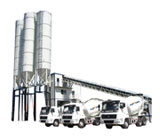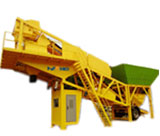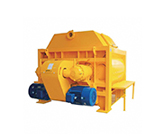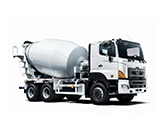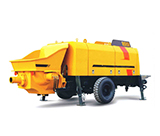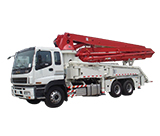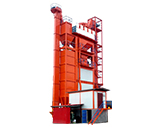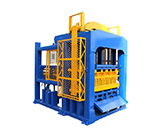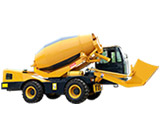How Is Concrete Batching Plant Automation Achieved?
2025.08.13
Concrete batching plant automation achieves automated control of the entire process, from raw material management to concrete production, through the coordinated integration of sensor detection, control system calculations and equipment execution. Its core goal is to reduce manual intervention and improve production accuracy, efficiency, and quality consistency.


The following are the specific implementation steps and technical details:
I. Automated Raw Material Storage and Monitoring
Raw materials for concrete production (sand, gravel, cement, fly ash, water, admixtures, etc.) must first be stored in dedicated silos. The automated system monitors this storage through the following methods:
1. Material Level Detection
- A material level sensor (such as an ultrasonic sensor, radar sensor, or capacitive sensor) is installed on the top of the silo to monitor the remaining raw materials in real time.
- The sensor transmits the material level signal to the central control system, which displays status information such as "full silo, normal, and low silo" on the monitoring interface.
- When the material level falls below a set threshold (such as the "low silo warning line"), the system automatically triggers an audible and visual alarm to remind the operator to replenish the raw materials. If the material level is too high (such as the "full silo protection line"), the loading equipment (such as belt conveyors and screw conveyors) automatically stops to prevent overflow.
2. Silo Error Prevention Design
- Silos for different raw materials are linked to the control system through coding or location identification to prevent the misuse of raw materials (e.g., mixing cement and fly ash).
- Some high-end concrete batching plants install material identification devices (such as laser particle size analyzers and near-infrared spectrometers) at the silo entrances to automatically verify that the raw materials entering the silos match the preset types.
II. Batching Automation (Core Precision Control)
Batching is a critical step in determining concrete quality. The ratio of each raw material must be precisely controlled according to the recipe. Automated implementation relies on a "weighing-feedback-adjustment" closed-loop control system:
1. Weighing System
- A load cell (such as a strain gauge load cell) is installed in the batching hopper (or conveyor path) for each raw material, with an accuracy of up to ±0.1%, to monitor the material weight in real time.
- For example, when batching sand and gravel, the sand and gravel enter the weighing hopper via a belt conveyor, and the load cell transmits the weight signal to the control system. Cement and fly ash enter the weighing hopper via a screw conveyor and are also monitored by a load cell.
2. PLC Control System Adjustment
- The control system (core is a programmable logic controller (PLC)) receives signals from the weighing sensors, compares them with the set values in the recipe, and automatically adjusts the feeding equipment (such as the speed of the belt conveyor, the frequency of the screw conveyor, and the opening of the water pump's flow valve).
- A "staged feeding" strategy is used to improve accuracy:
- Coarse feeding: The feeding equipment starts rapidly and slows down when it reaches 80%-90% of the target weight.
- Fine feeding: The feeding speed is low and stops when it approaches the target value to avoid overfeeding caused by inertia.
- If the weighing deviation exceeds the allowable range (e.g., ±0.5%), the system automatically refills or discharges the material (small deviations can be fine-tuned in subsequent steps).
III. Automated Mixing
After batching, the raw materials enter the main mixer for mixing. Automated control ensures uniform mixing and precise timing:
1. Preset Mixing Parameters
- The automatic control system presets the mixing time (usually 60-120 seconds) and main mixer speed based on the concrete grade (e.g., C30, C50). If adjustments are needed (e.g., extending the mixing time for winter construction), operators can modify parameters in the central control room, and the system will automatically synchronize the parameters to the main mixer.
2. Automatic Start/Stop and Protection
- After batching is complete, the system automatically starts the main mixer and opens the hopper discharge door to discharge the material into the main mixer.
- After the mixing time expires, mixing automatically stops and triggers the subsequent discharge process.
- If the main mixer is overloaded (e.g., due to a foreign object), the system automatically shuts down and issues an alarm to prevent equipment damage.
IV. Automated Unloading and Transportation Connections
After mixing, the mixed concrete needs to be unloaded into concrete mixer trucks. An automated system ensures efficient unloading and minimizes waste:
1. Tanker Positioning Detection
- A vehicle detection sensor (e.g., infrared beam sensor, ground sensor) is installed below the main mixer discharge port to detect whether the concrete mixer truck is in place.
- The system only allows the discharge door to open when the tank truck is parked in the designated location to prevent concrete spillage.
2. Discharge Control
- The discharge gate is actuated by an electric actuator or hydraulic valve. The control system automatically controls the gate opening and discharge time based on the tanker capacity (pre-set parameters).
- Some concrete batching plants are equipped with flow sensors to monitor the discharge volume in real time and automatically close the discharge gate when the target value is reached.
V. Central Monitoring and Data Management Automation
1. Human-Machine Interface (HMI)
- Operators monitor the entire process via a host computer (industrial computer) in the central control room. The interface displays in real time:
- Material levels in each silo, ingredient weight, mixing status, and equipment operating parameters (such as motor current and temperature);
- Production progress (volumes produced, remaining plan), and abnormal alarms (such as material shortages and equipment failures).
- Operators can enter production plans (such as concrete grade and volume) through the interface, and the system automatically calls the corresponding recipe, eliminating the need for manual calculations.
2. Data Recording and Traceability
- The system automatically records key data for each production run: recipe parameters, raw material quantities, mixing time, operator, and tanker information. This data can be stored for at least six months (meeting industry traceability requirements).
- Data export is supported (e.g., in Excel format), facilitating analysis of production efficiency, raw material loss, and optimization of recipes or equipment parameters.
3. Remote Monitoring and Linkage (Optional)
- Some smart concrete mixing stations are internet-connected, allowing users to monitor production status via a mobile app or remote computer.
- Linkage with the company's ERP system automatically synchronizes production data to procurement and finance modules, enabling raw material inventory alerts and automated cost accounting.
VI. Core Technology Support
- Sensors: Responsible for "sensing" (material level, weight, position, flow, etc.), serving as the "eyes" of automation;
- PLC control systems: Responsible for "calculation and decision-making," serving as the "brains" of automation;
- Actuators: Such as motors, valves, and actuators, responsible for "action," serving as the "hands and feet" of automation;
- Industrial buses: Such as Profibus and Modbus, enabling high-speed data transmission between sensors, PLCs, and host computers.
Advantages of Concrete Batching Plant Automation:
- Improved Precision:
Batching error is reduced from ±2%-5% in manual operation to within ±0.5%, ensuring stable concrete strength;
- Improved Efficiency:
Hourly output per station can be increased by 20%-30% (e.g., from 60 cubic meters/hour to 80 cubic meters/hour);
- Reduced Costs:
Reduced labor (a single concrete batching plant can eliminate 3-5 operators) and reduced raw material waste (typically by more than 5%);
- Safety and Reliability:
Automatic shutdown and alarm when equipment malfunctions occur, reducing safety incidents.
In summary, the concrete batching plant automation is a closed-loop system of “detection-control-execution”, which replaces key manual operations with technology to achieve efficient, accurate and stable production.

